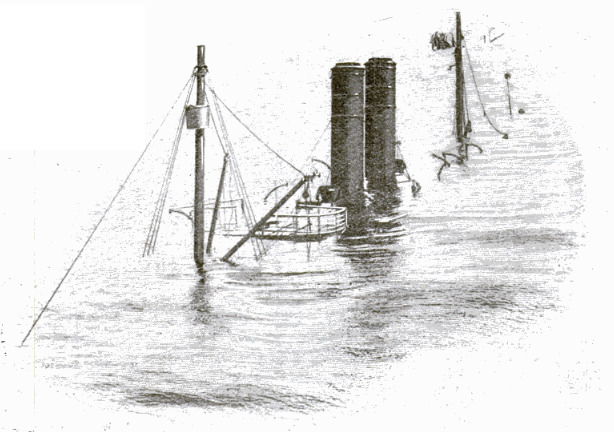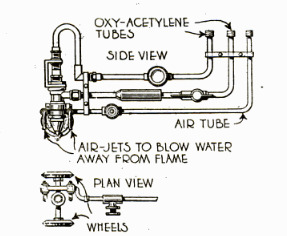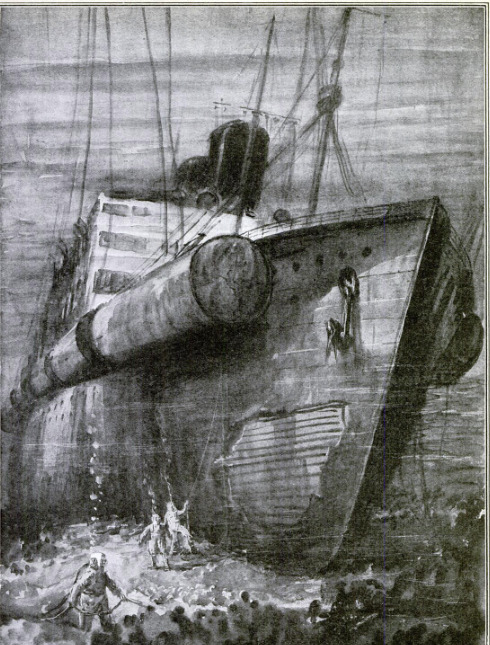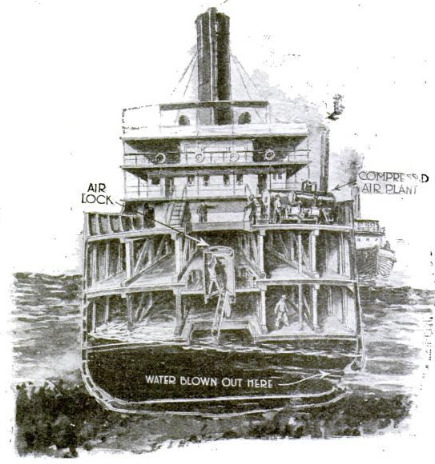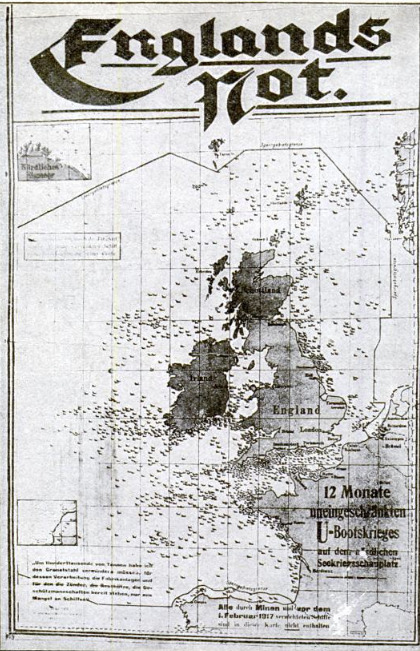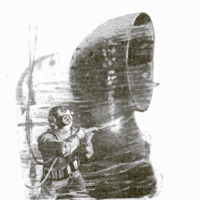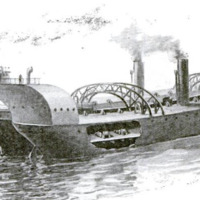-
Titolo
-
How ships and cargos sunk by the Germans can be recovered from the seabed
-
Article Title and/or Image Caption
-
Title: Lifting Sunken Tresure from the Sea
-
Subtitle: Ships and cargos worth billions were sunk by the Germans. Can that treasure ever be recovered?
-
extracted text
-
ACCORDING to an official
statement issued by the
United States Shipping
Board, the Allied and neutral
nations lost 21,404,193 dead-
weight tons of shipping during
the war, which means that
Germany maintained an aver-
age destruction of about 445,000
dead-weight tons monthly. Most
of the ships that were torpedoed
undoubtedly lie under water at
both low and high tide. Without
the aid of a diver, they would
remain there until they literally
dissolved. And so divers must
be sent down—exceptional men, amaz-
ing men, who perform under-water
feats of physical endurance that seem
well-nigh incredible, and who accom-
plish tasks in carpentry, fitting, and
blacksmithing that seem little short of
‘miraculous to the untutored layman.
Man Lives in an Air Ocean
Man is an animal that lives at the
bottom of an ocean of air. Like the
water of the sea, the ocean of air has
weight. At sea-level it presses upon
you with a force of fifteen pounds to
‘the square inch. Nature has fashioned
you so that you can eat and sleep and
walk about when the pressure of the
air upon you is somewhat less or some-
what more than fifteen pounds to the
square inch.
But there are limits. Some deep-
sea fish literally explode when they
are brought to the surface: the water-
‘pressure to which they are accustomed
has been removed. You will not ex-
plode if you dre raised by a balloon to
a height of five miles,’ but you are
likely to die for lac of air.
All these facts must be borne in
mind when one considers what is de-
manded of a diver. To send him
down in order that he may explore
a wreck is not 80 much a matter of
preventing him from drowning as it
is a matter of air-pressure. He must
breathe under conditions that were
never considered by nature. A cubic
foot of salt water weighs sixty-four
pounds.
The deeper a man descends,
the more cubic feet of water press
upon him. For every foot that he
goes down, the pressure increases about
half a pound to the square inch.
Clearly, a depth is soon reached at
which he would literally be squeezed
into a pulp, assuming that the water
can not enter his body. He would
be “imploded” —the opposite of
exploded.
The purpose of the diver's dress that
will be used by hundreds of men in
raising some of the treasure now at
the bottom of the ocean is not only to
prevent drowning, but to offset the
pressure of the ocean by pressure of air.
Why the Diver Is Not Squeezed
to Death
A divers dress consists essentially
of two parts—an incompressible helmet
and a compressible garment for the
body and legs. Down and down the
diver goes. The pressure increases.
It tries to force the air out of the
dress into the helmet. Air must be
pumped into the helmet and the upper
part of the dress until the pressure
‘within is equal to that without at the
level of the breast. The man breathes;
he exhales a poisonous gas—carbon-
dioxide. An escape must be provided
for the exhaled poisonous gas, as well
as to prevent the air-pressure within
from increasing beyond a desired
degree. So am automatic outlet valve
is provided in the helmet.
Blown up with air as he is, a diver
is like a bubble: he must be sunk.
Hence he carries about eighty pounds
of lead on his body and sixteen
pounds of lead in each boot. His
dress, exclusive of himself, weighs
about 175 pounds.
Air is supplied by means of a flex-
ible hose connected with an air-pump
in a boat above, or with a compressed
air tank. Besides the air-hose, the
diver is usually connected with the
surface by a signal line or life-line in
Which talephont wires aro embedded.
He descends by a ‘“shot-rope”—a
rope sunk by a heavy weight or
Vhot,
Iti evident that much dopands on
the airsupply and the airoutit valve
in’the helmet. The deeper the man
descends, the more air must be sup-
plied, since the pressure must increase
ith tha pressure of the water, If the
Pumps ate supplying one cuble foot of
Kira minute. when'the diver is near
the surface, they must supply two
cubic feet at thirty-three feet, three
cuble feet at sixty-six feet, four cubic
feet at inety-nine fea, eke, Ax the
pressure Increases, curioun disabilion
Spear, The. diver cannot whistler
for example, because he cannot make
his Tips vibrate. Hie voice. heard
over the telephone, becomes strangely
shrill and squeaky.
Moisture condenses on the front
glass of the helmet. He cannot see.
He” sucka in” mouthful of water
through a tap (the “spit-cock”) and
Apurte it over tho inside of the gam.
0 washed down, and al in clear
again
The Record for Diving
How doap can a divar descend? The
record in about three hundred feet or
thereabouts, made by divers of the
American Navy when the Ft wan
ised Some three years ago In the
ators of Honohuli. At ‘that great
depth Tittle work canbe done; the
diver can do little more than grope
around.
“Tha ai i composed of about eighty
per con nitrogen, a ka that dow not
Tandy enter no. chemical compo-
ition with other clamants and which
Serves the ‘purpose of diluting the
oxygen of the atmosphere so that
we may breathe it in the proper
amount.
The Perils of High Pressure
At high pressure the nitrogen pene-
trates the blood; it is not chemically
converted into something else that is
breathed out, as in the case of oxygen.
The deeper the diver descends, the
more nitrogen is forced into his blood
and tissues. If he is brought up from
a great depth too rapidly the nitrogen
bubbles off; the man suffers agonies;
he has all the symptoms of “‘caisson
disease” or the “bends”; he may die.
A table was compiled by the British
Admiralty, which is now consulted be-
fore sending men to the bottom of the
ocean in order to raise a sunken ship.
Is the depth 66 feet ? The engineer
refers to his table. “Twenty-nine
and a half pounds per square
inch,” he reads. That is the
pressure of the water. If
by any chance the diver
by any chance the diver
descends to 192 feet
and remains at that
depth over one hour,
the process of
bringing him up
will be tedious.
He will be held
for five minutes
at a depth of
eighty feet; for
twenty minutes
at a depth of
seventy feet;
for twenty-five
minutes at six-
tyfeet; for thir-
ty minutes at a
depth of fifty
feet; for thirty
minutes at
forty feet; for thirty-five minutes at
thirty feet; for forty minutes at
twenty feet; and for a final forty
minutes at ten feet. In all, three
hours and forty-five minutes must
elapse between the time that the
man starts to come up and the time
that he is clear of the water, in |
order that the nitrogen may be |
slowly and safely released from his
system.
Problems for the Salvor |
How does the diver ascend? He
tightens up his air-valve. Hisbuoy-
ancy is increased. It becomes pos-
sible for him more or less to float
up the shot-rope. With each foot
of ascent the volume of air in the
dress expands; the speed is quick-
ened. At first the logs and arms
can be moved easily enough, so that,
the diver can hold the rope and ad-
just his valve to suit the changing |
conditions. Soon the dress blows
up hard as a board; he is as helpless
as if he were shackled; he cannot
reach out and adjust ‘the valve.
What, then, becomes of the excess
air? Tt escapes through the cuffs. |
There is no magic procedure appli-
cable to the salving of every wreck. A -
salvage engineer must study each case
on its own technical merits, and he |
must invent the peculiar technique
that is to be followed in a given in-
stance. Just as a surgeon must con-
sider the age, structure, physical
strength, and vitality of a patient, so
must the salvage engineer take into
account the position of the foundered
vessel, the nature of the extent of the
damage she has sustained, and the
character of the salvaging machinery
that is at his disposal.
The methods which were employed
in salvaging
one ship are not
likely to be
applicable in
every respect
to the raising of
another. The
salvor must be
ableto estimate
the weight,
trim, and sta-
bility of a ship
in her damaged
condition, and
quick to form
a plan of oper-
ation, taking
into account
the position of
the vessel, the
nature and ex-
tent of dam-
age which may
havebeendone,
the tide and
currents of the
water in which
she lies, and the character of the plant
at his disposal.
If a ship cannot be raised, at least
her cargo may often be salved. With
pneumatic drills or with the oxy-
acetylene torch (a blast of air keeps
the water away from the flame) a hole
can be cut in the plating of a ship as
she lies on her side, and through that
hole her cargo can be raised. Is the
cargo steel? Then the electric lifting
magnet is lowered. It fastens itself
with leechlike tenacity to as much as
it can carry. Gold, copper, silver,
must be raised by other means.
Orange-peel and similar buckets will
raise coal and other bulk cargo.
The Case of the “Lusitania”
"he quickest way of entering a hold
ie u dynamite an opening; but nowa-
days that method is resorted to but
rarely because the tangled mass of
wreckage that results imperils the
diver and makes his work more diffi-
cult. Perhaps that is the method
that may be employed to salve the
cargo of the
Lusitania. The
ship herself is
probably ir-
recoverable;
for she liesat a
depth of 300
feet in the open
‘water.
Ships of un-
der 2,000 tons
are usually
raised by. slip-
ping under
them chains or
cables, which
are fastened se-
curely to barges
or hulks at the
surface.
As the tide
rises the vessels
at the surface
also rise, lifting
the ship below,
by means of
the chains or
cables. The barges are then towed into
shallower water, and the chains are
tightened. At the next rise of the
tide the process is repeated.
Sometimes pontoons (huge specially
constructed steel cylindrical tanks)
are sunk beside the vessel and fastened
in place by divers. The water in the
tanks is then pumped out. Such is the
buoyancy of the pontoons that the
vessel rises. Large ships have thus
been raised —for example,
the British cruiser Gladiator,
a ship 320 feet long, dis- |
placing 5,500 tons. |
As a_ general rule, the |
salvor first tries to clear |
away wreckage, which is |
done by means of an under- |
water oxy-acetylene torch, |
or by dynamite, and then
closes all the larger holes.
Weight of the Sea |
The seas weight affects
not only the diver but the
sunken ship. Pile cubic
foot upon cuble foot of
water, and it follows that
at the deepest part of the |
ocean the pressure must be
measured by tons to the
square inch. At sixty feet,
for example, the pressure is
26.7 pounds to the square
inch; at one hundred and
fifty feet 66.7 pounds; at
three hundred feet 133.3 |
pounds. The raising of a |
sunken ship is complicated |
not only because its hold is
inundated with water, but
because of this weight.
How fast can a man in a |
ordinary dress work under
water? "A one-inch hole can
be drilled in mild steel at |
the rate of one to one and
a quarter inches a minute. |
An inch hole can be bored |
into timber with a pneu-
matic auger at the rate
of three to six inches a
minute. |
How is the opening made |
by a torpedo closed? Its
general shape and size must be known.
With the aid of an adjustable mold of
wood, the diver indicates the general
size and shape of a patch that will
close the hole. Next, the patch is
constructed of steel piates or plank-
ing, lowered, and drawn into place by
cables outside and inside of the hold.
To secure a patch in place, bolts are
employed.
Instead of patching holes and pump-
ing out a ship, the salvor may decide
10 blow the water out of her. In other
words, he opposes air-pres-
sure to water-pressure, ex-
actly as air-pressure is
opposed to water-pressure
in the diver’s dress.
‘The first step is to brace
or strengthen the decks, so
that they will not burst as
a result of the airpressure.
Port-holes, funnels, all the
‘openings, are tightly closed.
The next step consists in
providing access to the com-
partment. What is called
an air-lock is applied to the
cover of the hatchway. An
airlock consists simply of a cham-
ber that has a door communicating
with the outside and a second door
communicating with the hold.
+ The diver enters and closes the outer
door behind him. He then passes
through the second door into the hold,
and closes that door behind him too;
for the hold is full of compressed air
which must not be allowed to escape in
100 great quantities.
These air-pressures must be care-
fully considered by the salvage engi-
neer. The decks of a ship
are not intended to support
thousands of tons of water.
Hence it is often necessary .
to shore a ship so that
when she is pumped out
they will not collapse. And
this shoring must be done
in inky blackness.
The openings closed and
the air-lock in place, air is
pumped in. The pressure
of the air must be greater
than that of the water.
Gradually the water is
blown out through a con-
venient vent, sometimes the
very leak through which
it entered; but the salvor
usually relies upon-a scup-
per-pipe.
Allies’ Saloage Plans
That a systematic effort
will be made to raise the
ships that can besalved may
be inferred from the fact
that not: only have the
United States and the Allies
studied the problem individ-
ually, but that they have
pooled their salvage facili-
ties and formed a joint
salvage council. Fully one
quarter of the world's ship-
ping lies at the bottom of
the ocean.
Ships and cargo sunk by
mine and torpedo are
worth about three billion
dollars at present market
prices. for labor and ma-
terials. Up to date the
British Salvage Department
has salved more than 470
ships. But most of them were re-
covered before they had actually sunk.
Raising Ships of 2,800 Tons
Before the war it was considered
impossible to salve vessels of more than
1,600 tons if they lay in deep water;
but since the war vessels of 2,800 tons
have been raised.
Most of the ships that went down
were sunk in open water. It is con-
sidered a feat to raise a ship in a pro-
tected harbor, if she lies in a
hundred feet of water. But
out in the open the depth
must be less than a hundred
feet, particularly in a region
where the winds are high
and the sea rough, if
salvage operations are to
be successfully conducted.
Only those ships which
have been sunk close to
shore in a more or
less sheltered position
are likely to be raised.
‘The commercial risk in the
open is too great.
-
Autore secondario
-
Walter Bannard (Article writer)
-
Lingua
-
eng
-
Data di rilascio
-
1919-04
-
pagine
-
54-58
-
Diritti
-
Public domain (Google digitized)
-
Archived by
-
Davide Donà
-
Marco Bortolami (editor)
